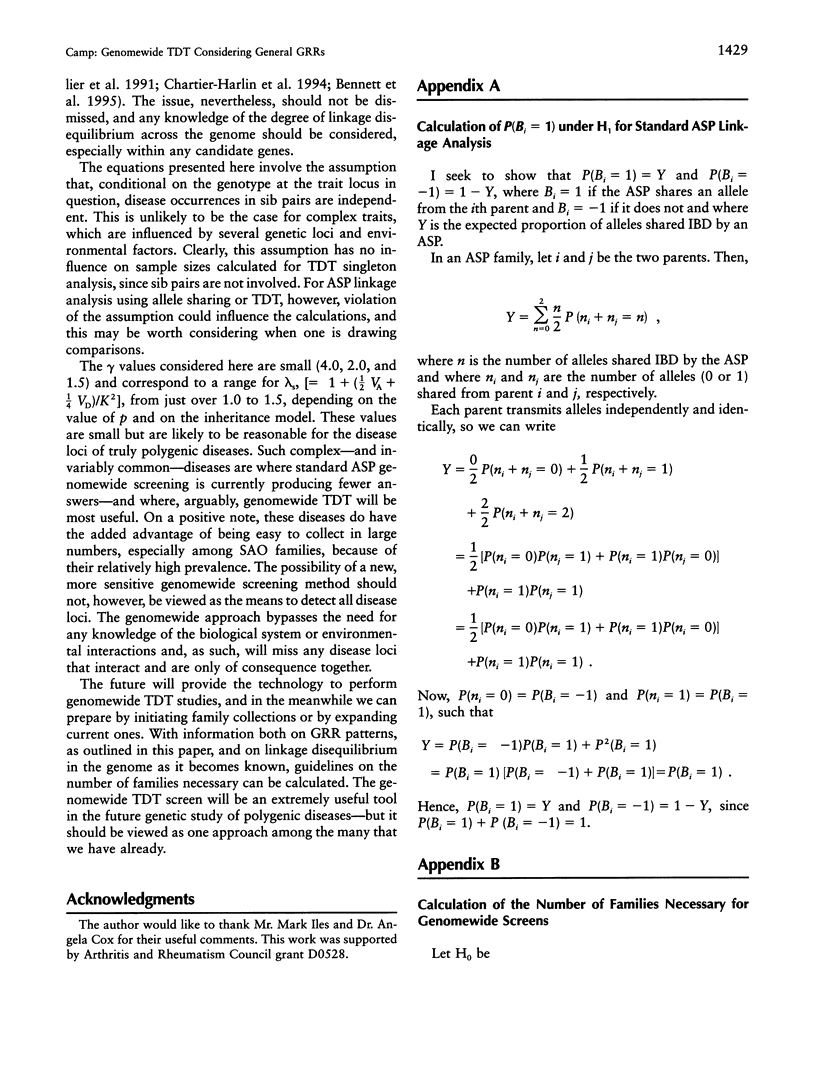Abstract
Genomewide association studies are set to become the tool of the future for detection of small-effect genes in complex diseases. It will therefore be necessary to calculate sufficient sample sizes with which to perform them. In this paper I illustrate how to calculate the required number of families for general genotypic relative risks (GRRs). I show the superior sensitivity of the genomewide association study over the standard genomewide affected-sib-pair linkage analysis, for a range of different underlying GRR patterns. I also illustrate the extent of change in the sample sizes that is necessary for a genomewide association analysis depending on the pattern of the GRRs at the disease locus. In many cases, the comparative numbers of families required under different genetic mechanisms vary by several orders of magnitude. These sometimes dramatic differences have important implications for the determination of the size of the collection of samples prior to analysis and for the types of effects that are likely--and unlikely--to be detected by such an analysis.
Full text
PDF






Selected References
These references are in PubMed. This may not be the complete list of references from this article.
- Bennett S. T., Lucassen A. M., Gough S. C., Powell E. E., Undlien D. E., Pritchard L. E., Merriman M. E., Kawaguchi Y., Dronsfield M. J., Pociot F. Susceptibility to human type 1 diabetes at IDDM2 is determined by tandem repeat variation at the insulin gene minisatellite locus. Nat Genet. 1995 Mar;9(3):284–292. doi: 10.1038/ng0395-284. [DOI] [PubMed] [Google Scholar]
- Chartier-Harlin M. C., Parfitt M., Legrain S., Pérez-Tur J., Brousseau T., Evans A., Berr C., Vidal O., Roques P., Gourlet V. Apolipoprotein E, epsilon 4 allele as a major risk factor for sporadic early and late-onset forms of Alzheimer's disease: analysis of the 19q13.2 chromosomal region. Hum Mol Genet. 1994 Apr;3(4):569–574. doi: 10.1093/hmg/3.4.569. [DOI] [PubMed] [Google Scholar]
- Field L. L., Fothergill-Payne C., Bertrams J., Baur M. P. HLA-DR effects in a large German IDDM dataset. Genet Epidemiol Suppl. 1986;1:323–328. doi: 10.1002/gepi.1370030749. [DOI] [PubMed] [Google Scholar]
- Julier C., Hyer R. N., Davies J., Merlin F., Soularue P., Briant L., Cathelineau G., Deschamps I., Rotter J. I., Froguel P. Insulin-IGF2 region on chromosome 11p encodes a gene implicated in HLA-DR4-dependent diabetes susceptibility. Nature. 1991 Nov 14;354(6349):155–159. doi: 10.1038/354155a0. [DOI] [PubMed] [Google Scholar]
- Lander E., Kruglyak L. Genetic dissection of complex traits: guidelines for interpreting and reporting linkage results. Nat Genet. 1995 Nov;11(3):241–247. doi: 10.1038/ng1195-241. [DOI] [PubMed] [Google Scholar]
- Müller-Myhsok B., Abel L. Genetic analysis of complex diseases. Science. 1997 Feb 28;275(5304):1328–1330. [PubMed] [Google Scholar]
- Risch N., Merikangas K. The future of genetic studies of complex human diseases. Science. 1996 Sep 13;273(5281):1516–1517. doi: 10.1126/science.273.5281.1516. [DOI] [PubMed] [Google Scholar]
- Spielman R. S., Ewens W. J. The TDT and other family-based tests for linkage disequilibrium and association. Am J Hum Genet. 1996 Nov;59(5):983–989. [PMC free article] [PubMed] [Google Scholar]
- Spielman R. S., McGinnis R. E., Ewens W. J. Transmission test for linkage disequilibrium: the insulin gene region and insulin-dependent diabetes mellitus (IDDM). Am J Hum Genet. 1993 Mar;52(3):506–516. [PMC free article] [PubMed] [Google Scholar]
- Suarez B. K., Rice J., Reich T. The generalized sib pair IBD distribution: its use in the detection of linkage. Ann Hum Genet. 1978 Jul;42(1):87–94. doi: 10.1111/j.1469-1809.1978.tb00933.x. [DOI] [PubMed] [Google Scholar]


